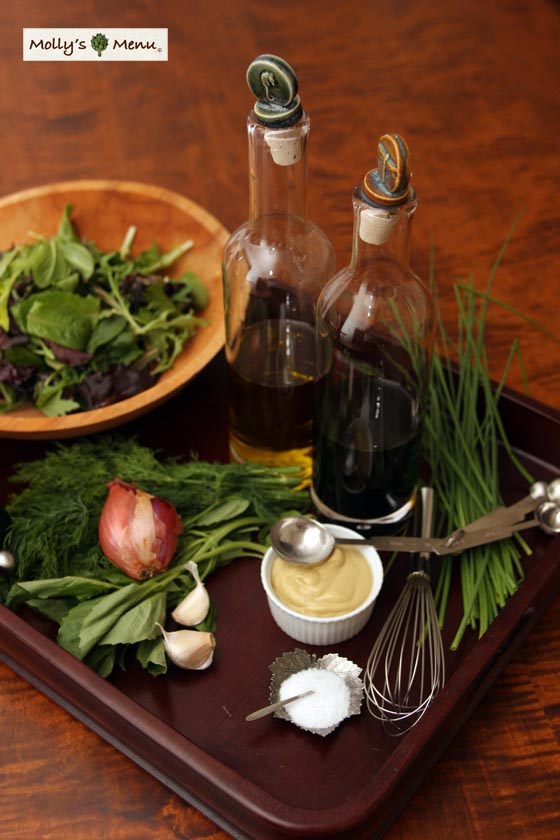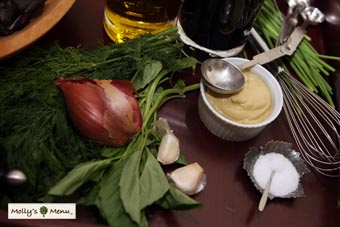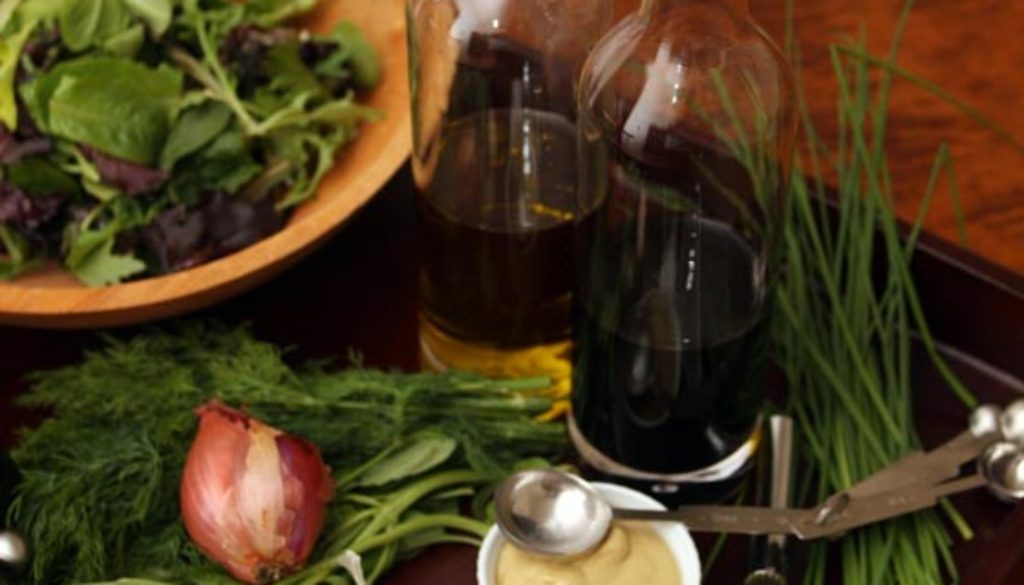Kitchen Fundamentals 107: Salad Dressings, Part I of III
 Part I: Vinaigrettes
Part I: Vinaigrettes
It has been many years since I have counted a store bought salad dressing among my pantry staples. In my opinion, it is pointless to prepare a fresh homemade salad only to offer a selection of prefabricated bottled concoctions along side it. The veggies quickly become muted by an overbearing blend of artificial ingredients that never quite achieve the right balance of flavor or mouth feel. I know that many people would argue that it is a matter of convenience, but with a handful of ingredients kept on stock, a homemade vinaigrette in only a matter of minutes. Done properly, it should gently flatter the vegetables it coats rather than drown them in a muddle of flavors. And with little more equipment than a blender, small whisk, sharp knife and bottom of a salad bowl it can be achieved rather effortlessly. Over the next several installments of Fundamentals I will share with you what I consider to be my canon of salad dressing recipes.
● Classical French Dijon Vinaigrette
This is by far the most widely used recipe in my house. It can be made straight in the bottom of your salad bowl before all of the greens and veges are added. It is a vinaigrette often found in French bistro cooking, and suits a pile of tender young lettuces quite nicely with a garnish of freshly chopped herbs. I also love it tossed into some quickly steamed asparagus that have been plunged into an ice bath to cool down before drying and drizzling on the vinaigrette. I typically don’t bother with measurements, and once you get the hang of it you can decide your preference for the right ratio of vinegar to oil and whether you prefer it on the sweeter side or not.
Mustard works as an emulsifier here, and it adds thickness and depth to the vinaigrette. It can be eliminated for a lighter, simpler dressing. Red wine and balsamic can be used interchangeably, and I often use a combination of the two or sometimes substitute sherry vinegar for one or the other.
Recipe:
1/8 C extra virgin olive oil
1/8 C canola oil
1 tsp Dijon
½ tsp Honey
2 Tbsp red wine vinegar
2 Tbsp balsamic or sherry vinegar
Salt & pepper
(optional: add 1 Tbsp finely chopped shallots, or 1 tsp grated raw garlic clove to the base of the vinaigrette to add sharpness and complexity
Method:
Place mustard, honey and vinegar in the bottom of your salad bowl with a pinch of salt and pepper and whisk to combine. Very slowly drizzle in oil as you continue to whisk to emulsify the liquid. Taste and adjust seasoning as desired.
Variations:
Greek Vinaigrette:
For a traditional Greek salad, eliminate the lemon and honey. In place of the balsamic/sherry vinegar substitute 2 Tbsp fresh lemon juice along with 1 tsp finely chopped fresh or dried oregano.
Grandmother’s Blue Cheese:
My Grandmother’s house salad was always topped with this variation of the classic vinaigrette. Add 1 finely grated clove of raw garlic to the base dressing in addition to 3 Tbsp of crumbled blue cheese. The cheese and the mustard compliment each other well, and this version is delicious poured over a stack of sliced, ripe summer tomatoes with red onion, basil and crumbled browned bacon.
Sherry Walnut:
Substitute toasted walnut oil for the olive oil, and use Sherry vinegar (preferably aged, from Jerez) for all 4 Tbsp (in place of balsamic or red wine). Increase the amount of honey to 1 full tsp. This dressing is particularly good in a salad with thinly sliced apples or pears, shaved manchego or gouda cheese and a mix of bitter greens.
Warm Bacon and Balsamic:
Slice 4 pieces of thick slab bacon into matchstick pieces them brown them in an empty pan over medium heat until the fat has rendered, and the bacon pieces are a crispy golden brown. Add 2 Tbsp finely diced shallots to the hot bacon and cook for about 2 minutes. Add 2 Tbsp balsamic vinegar and freshly cracked pepper then pour the warm dressing over a spinach salad. The salad can be garnished with caramelized onions, blue cheese and chopped hard boiled eggs.




